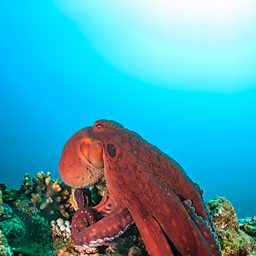10 incredible facts about Octopuses
With brain cells running through its entire body, the octopus is a playful, inquisitive and mischievous creature whose abilities may surprise you. In his new audiobook, Other Minds: The Octopus And The Evolution Of Intelligent Life, the philosopher and scuba diver Peter Godfrey-Smith explores the startling evolutionary journey of the cephalopods.
Here are just a few of the amazing things we learned about these incredible invertebrates.
1. The octopus is a pretty clever animal, but with most of its brain cells actually in its “arms”
Octopuses have a large nervous system, with the average octopus having about 500 million neurons or brain cells. That puts it in the same “brain range” as smaller mammals such as dogs. Unlike dogs, humans and others, most of the neurons are found in the arms of the octopus and not the brain – in fact nearly twice as many. Each sucker on an octopus’s arm may have 10,000 neurons to handle taste and touch.

In an experiment, octopuses learned to pull a lever to get a reward
2. Octopuses can be trained and have memory skills
Research from the mid-20th century showed that octopuses could be trained to perform simple tasks. In one particular experiment, a number of octopuses were able to pull a lever to get a reward – a piece of sardine.
Octopuses have also undergone visual tests, with simple tasks remembered first with one eye covered and then the other. It was a long process, but the octopus outperformed many other animals, including pigeons!
3. Don’t get on the wrong side of an octopus – they’re highly mischievous
In the lever experiment mentioned above, three octopuses were involved – they were named Albert, Bertram and Charles. Albert and Bertram were the most consistent performers while Charles was a bit wayward and broke the lever! If that wasn’t enough, Charles would also squirt jets of water at whoever was conducting the experiment that day!
Misbehaving octopuses have been reported in various aquariums, including ones which have learned to turn off the lights by squirting jets of water at the bulbs and short-circuiting the power supply. At the University of Otago in New Zealand, this became so expensive that an octopus had to be released back to the wild!
4. Octopuses recognise individual people
In the same lab in New Zealand that had the “lights-out” problem, an octopus took a dislike to one member of the lab staff, for no obvious reason. Whenever that person passed by, she received a jet of half a gallon of water to the back of her neck!

5. Octopuses like to play
Perhaps hardly surprising, given their mischievous antics described above, they are playful creatures. Some octopuses in labs have been seen to spend time blowing pill bottles around their tank with their jet, bouncing the bottle back and forth on the stream of water coming from the tank’s intake valve.
6. Octopuses reproduce arm-in-arm
For many species of octopus, you can tell if they are male or female if they have a groove under their third right arm. If there is, it’s a male and they use this arm in mating. What they do is to stretch out that arm towards the female and, if she accepts it, a packet of sperm is passed along the underside of the arm. The females often then store the sperm for some time before fertilizing their eggs.
7. “High-fives” are a standard greeting in the world of an octopus
When octopuses are on the move they are sometimes seen to “lash out” with their arms at other octopuses in their dens. However, Professor Stefan Linquist, who has studied octopus behaviour, believes that these interactions are actually “high fives” – arm-slaps that help octopuses recognise each other.
8. An octopus has multiple hearts
An octopus has three hearts! Its hearts pump blood that is blue-green, using copper as the oxygen-carrying molecule instead of the iron which makes
our blood red.
9. When they need to be, octopuses can be scary!
Octopuses can change colour and pattern. When an aggressive male is about to attack another octopus, he will often turn dark, rise out of the seabed, and stretch his arms out in a way that magnifies his apparent size. Sometimes he will raise his mantle, the entire rear part of his body, over his head – this is nicknamed the “Nosferatu” pose after its similarity to the posture of a vampire.
10. Not having a skeleton has some advantages for the octopus.
Having no skeleton or shell is unusual for an animal with the size and complexity of an octopus. Their make-up does make them more vulnerable to predators on one level, but it also enables them to hide. An octopus can squeeze through
a hole about the size of its eyeball and transform its body shape almost without limits.

To learn more, listen to Other Minds: The Octopus, the Sea, and the Deep Origins of Consciousness by Peter Godfrey-Smith
More from Radio 4
-
![]()
39 Ways to Save the Planet
Tom Heap presents 39 ideas to relieve the stress that climate change is exerting on the planet.
-
![]()
Natural Histories
Nature that has got under our skin and profoundly impacted human culture and society across our history.
-
![]()
On the Menu
Adam Hart explores our relationship with some of the animal kingdom's deadliest predators.
-
![]()
Go Wild
Nature documentaries to inspire your next outdoors adventure introduced by Harriet Noble.





